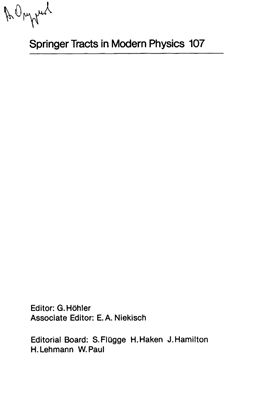Springer-Verlag, 1985, 233 p.
This book is conceed with the electronic structure and excited-state nonradiative relaxation phenomena in pure rare-gas solids (RGS), alloys of rare gases, solid two-component mixtures, metals in rare-gas solids, pure rare-gas liquids and liquid mixtures. Starting from the experimental point of view the techniques utilized to probe the optical constants, transient absorption, energy- and time-resolved luminescence, as well as photoelectron yield and energy distribution are considered. In the survey of the electronic structure of valence bands, conduction bands and excitonic states in pure RGS, recent new experimental and theoretical results for bulk excitations and for surface excitons are emphasized. This is followed by a review of electronic excitations in rare-gas alloys and liquid rare gases. Next, basic properties of metal rare-gas solid mixtures are considered and information is gained conceing electronic structure, transport properties and metal-nonmetal transitions.
Knowledge of the electronic structure provides the basic input data required for the elucidation of excited-state dynamics in condensed rare gases. We discuss the experimental information obtained from luminescence and photoemission studies and the available theoretical framework pertaining to the microscopic relaxation processes in solid and liquid rare gases. A variety of dynamic processes occur, including exciton trapping, vibrational relaxation, electronic relaxation, electronic energy migration via exciton states, electronic energy transfer between localized states, autoionization and electron-hole recombination. Finally, electron transport properties and electron-hole pair creation processes for electrons with kinetic energies of a few eV up to the MeV region are treated and discussed in terms of the electronic structure and the dynamical processes involved. We emphasize the effects of structural and compositional disorder on the electronic properties and are conceed with the microscopic aspects of excited-state energy conversion, storage and disposal in these materials.
This book is conceed with the electronic structure and excited-state nonradiative relaxation phenomena in pure rare-gas solids (RGS), alloys of rare gases, solid two-component mixtures, metals in rare-gas solids, pure rare-gas liquids and liquid mixtures. Starting from the experimental point of view the techniques utilized to probe the optical constants, transient absorption, energy- and time-resolved luminescence, as well as photoelectron yield and energy distribution are considered. In the survey of the electronic structure of valence bands, conduction bands and excitonic states in pure RGS, recent new experimental and theoretical results for bulk excitations and for surface excitons are emphasized. This is followed by a review of electronic excitations in rare-gas alloys and liquid rare gases. Next, basic properties of metal rare-gas solid mixtures are considered and information is gained conceing electronic structure, transport properties and metal-nonmetal transitions.
Knowledge of the electronic structure provides the basic input data required for the elucidation of excited-state dynamics in condensed rare gases. We discuss the experimental information obtained from luminescence and photoemission studies and the available theoretical framework pertaining to the microscopic relaxation processes in solid and liquid rare gases. A variety of dynamic processes occur, including exciton trapping, vibrational relaxation, electronic relaxation, electronic energy migration via exciton states, electronic energy transfer between localized states, autoionization and electron-hole recombination. Finally, electron transport properties and electron-hole pair creation processes for electrons with kinetic energies of a few eV up to the MeV region are treated and discussed in terms of the electronic structure and the dynamical processes involved. We emphasize the effects of structural and compositional disorder on the electronic properties and are conceed with the microscopic aspects of excited-state energy conversion, storage and disposal in these materials.

